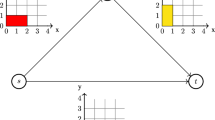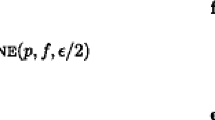Abstract
LetD=(V, A) be a directed graph. A real-valued vectorx defined on the arc setA is amax-balanced flow forD if for every cutW the maximum weight over arcs leavingW equals the maximum weight over arcs enteringW. For vectorsl⩽u defined onA, we describe an analogue of Hoffman's circulation conditions for the existence of a max-balanced flowx satisfyingl⩽x⩽u. We describe an algorithm for computing such a vector, but show that minimizing a linear function over the set of max-balanced flows satisfyingl⩽x⩽u is NP-hard. We show that the set of all max-balanced flows satisfyingl⩽x⩽u has a greatest element under the usual coordinate partial order, and we describe an algorithm for computing this element. This allows us to solve several related approximation problems. We also investigate the set of minimal elements under the coordinate partial order. We describe an algorithm for finding a minimal element and show that counting the number of minimal elements is #P-hard. Many of our algorithms exploit the relationship between max-balanced flows and bottleneck paths.
Similar content being viewed by others
References
R.E. Burkard, R.A. Cuninghame-Green and U. Zimmermann,Algebraic and Combinatorial Methods in Operations Research. Annals of Discrete Mathematics No. 19 (North-Holland, Amsterdam, 1984).
R.E. Burkard and U. Zimmermann, “Combinatorial optimization in linearly ordered semimodules: A survey,” in: Bernhard Korte, ed.,Modern Applied Mathematics — Optimization and Operations Research (North-Holland, Amsterdam, 1982).
R. Cuninghame-Green,Minimax Algebra. Lecture Notes in Economics and Mathematical Systems No. 166 (Springer, Berlin, 1970).
R.B. Dial and A.M. Voorhees, “Algorithm 360: Shortest-path forest with topological ordering,”Communications of the ACM 12(11) (1969) 632–633.
J. Edmonds and D.R. Fulkerson, “Bottleneck extrema,”Journal of Combinatorial Theory 8 (1970) 299–306.
J. Edmonds and R.M. Karp, “Theoretical improvements in algorithmic efficiency for network flow problems,”Journal of the Association of Computing Machinery 19(2) (1972) 248–264.
G.M. Engel and H. Schneider, “Diagonal similarity and equivalence for matrices over groups with 0,”Czechoslovak Mathematical Journal 25 (1975) 389–403.
K.P. Eswaran and R. E. Tarjan, “Augmentation problems,”SIAM Journal on Computing 5(4) (1976) 653–665.
L.R. Ford, Jr. and D.R. Fulkerson,Flows in Networks (Princeton University Press, Princeton, NJ, 1962).
M.L. Fredman and R. Endre Tarjan, “Fibonacci heaps and their use in improved network optimization algorithms,”Journal of the Association of Computing Machinery 34 (1987) 596–615.
M.R. Garey and D.S. Johnson,Computers and Intractability: A Guide to the Theory of NP-Completeness (Freeman, San Francisco, CA, 1979).
H. Hamacher, “Algebraic flows in regular matroids,”Discrete Applied Mathematics 2 (1980) 27–38.
H. Hamacher, “Decomposition of group flows in regular matroids,”Computing 29 (1982) 113–133.
H. Hamacher, “Maximal algebraic flows: Algorithms and examples,” in: U. Pape, ed.,Discrete Structures and Algorithms (Carl Hauser Verlag, Munich, 1980) pp. 153–166.
H. Hamacher, “Minimal cost flows in regular matroids,”Mathematical Programming Studies 14 (1981) 32–47.
M. Hartmann and M.H. Schneider, “Flow symmetry and algebraic flows,” Technical Report UNC/OR/TR 91-4, The University of North Carolina (Chapel Hill, NC, 1991).
M. Hartmann and M.H. Schneider, “Max-balanced flows in oriented matroids,” OR Group Report Series, The Johns Hopkins University (Baltimore, MD, 1991).
A.J. Hoffman, “On abstract dual linear programs,”Naval Research Logistics Quarterly 10 (1963) 369–373.
A.J. Hoffman, “Some recent applications of the theory of linear inequalities to extremal combinatorial analysis,” in: R. Bellman and M. Hall, Jr., eds.,Combinatorial Analysis, proceedings of Symposia on Applied Mathematics, Vol. X (American Mathematical Society, 1960) pp. 113–127.
L. Lovász, “Connectivity in digraphs,”Journal of Combinatorial Theory, Series B 15 (1973) 174–177.
K. Mehlhorn,Data Structures and Algorithms 2: Graph Algorithms and NP-Completeness. EATCS Monographs on Theoretical Computer Science No. 2 (Springer, Berlin, 1984).
M. Pollack, “The maximum capacity through a network,”Operations Research 8(5) (1960) 733–736.
M. Pollack and W. Wiebenson, “Solutions of the shortest-route problem — A review,”Operations Research 8(2) (1960) 225–230.
U.G. Rothblum, H. Schneider and M.H. Schneider, “Characterizations of max-balanced flows,” to appear in:Discrete Applied Mathematics.
H. Schneider and M.H. Schneider, “Anl ∞ balancing of a weighted directed graph,” OR Group Report Series #88-1, The Johns Hopkins University (Baltimore, MD, 1987).
H. Schneider and M.H. Schneider, “Max-balancing weighted directed graphs and matrix scaling,”Mathematics of Operations Research 16(1) (1991) 208–220.
H. Schneider and M.H. Schneider, “Towers and cycle covers for max-balanced graphs,”Congressus Numerantium 73 (1990) 159–170.
R. Tarjan, “Depth first search and linear graph algorithms,”SIAM Journal on Computing 1 (1972) 146–160.
R.E. Tarjan,Data structures and Network Algorithms. CBMS-NSF Regional Conference Series in Applied Mathematics No. 44 (SIAM, Philadelphia, PA, 1983).
L.G. Valiant, “The complexity of enumeration and reliability problems,”SIAM Journal on Computing 8(3) (1979) 410–421.
R.A. Wagner, “A shortest path algorithm for edge-sparse graphs,”Journal of the Association of Computing Machinery 23(1) (1976) 50–57.
U. Zimmermann, “Duality for algebraic linear programming,”Linear Algebra and its Applications 32 (1981) 9–31.
U. Zimmermann,Linear and Combinatorial Optimization in Ordered Algebraic Structures. Annals of Discrete Mathematics No. 10 (North-Holland, Amsterdam, 1981).
Author information
Authors and Affiliations
Additional information
Research supported in part by NSF grant DMS 89-05645.
Research supported in part by NSF grant ECS 87-18971.
Rights and permissions
About this article
Cite this article
Hartmann, M., Schneider, M.H. An analogue of Hoffman's circulation conditions for max-balanced flows. Mathematical Programming 57, 459–476 (1992). https://doi.org/10.1007/BF01581095
Received:
Revised:
Issue Date:
DOI: https://doi.org/10.1007/BF01581095




